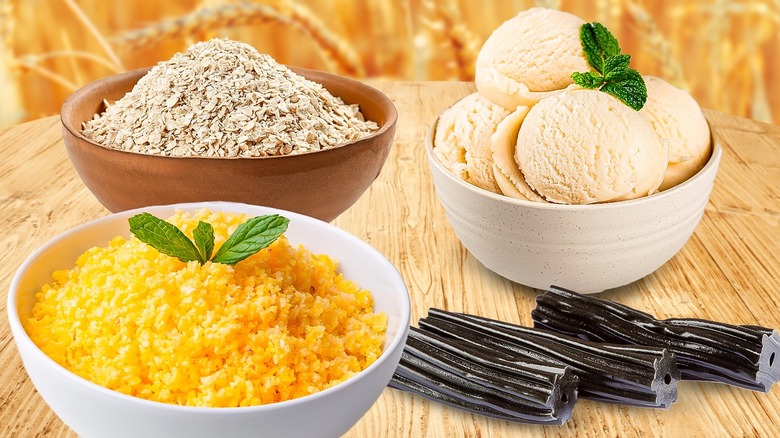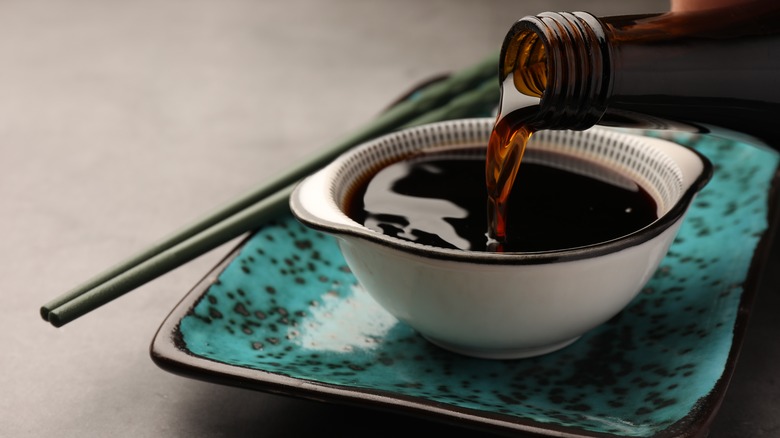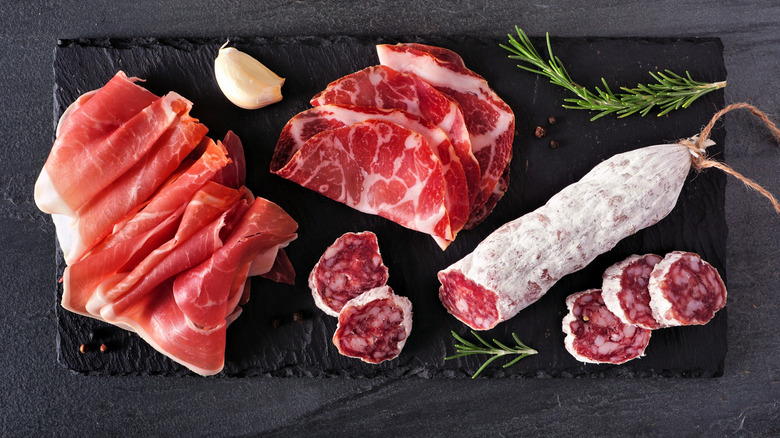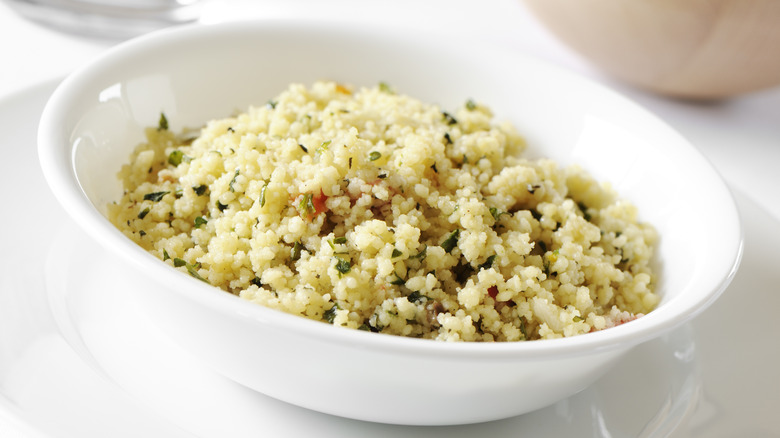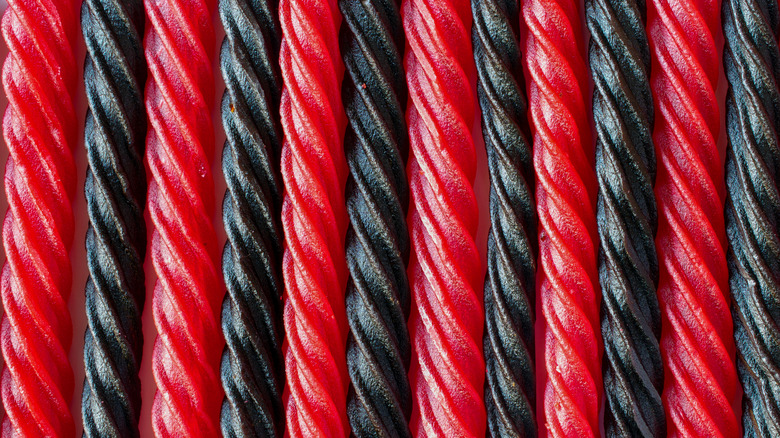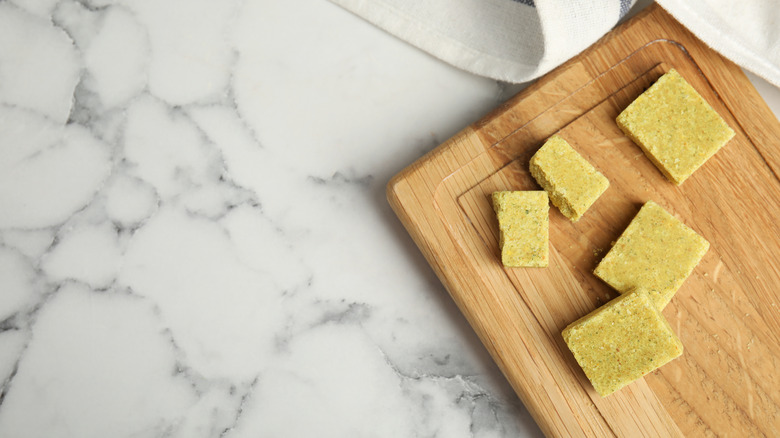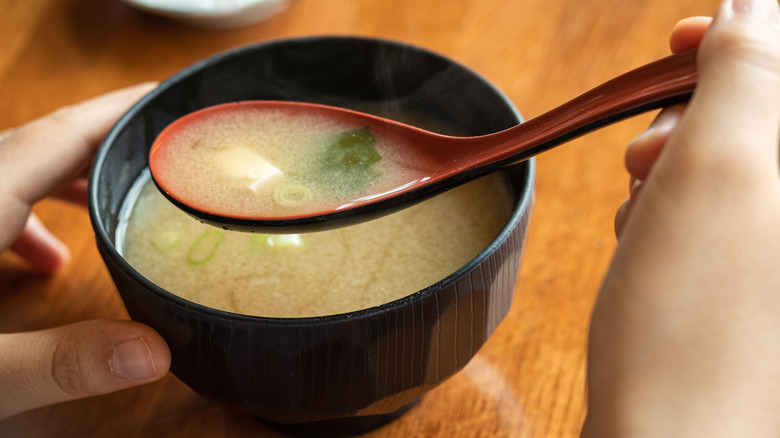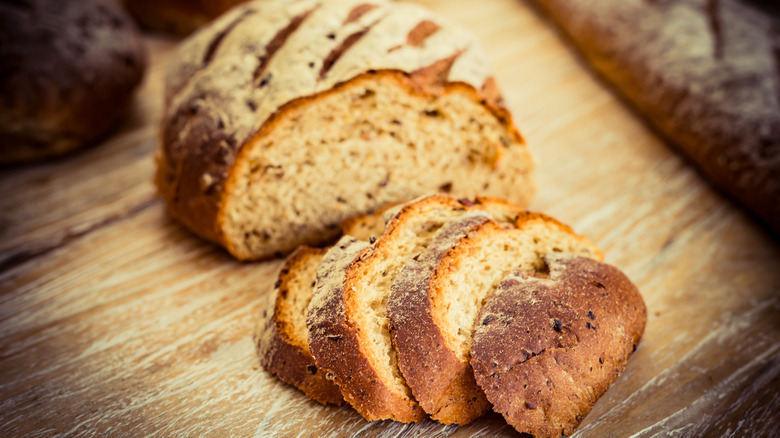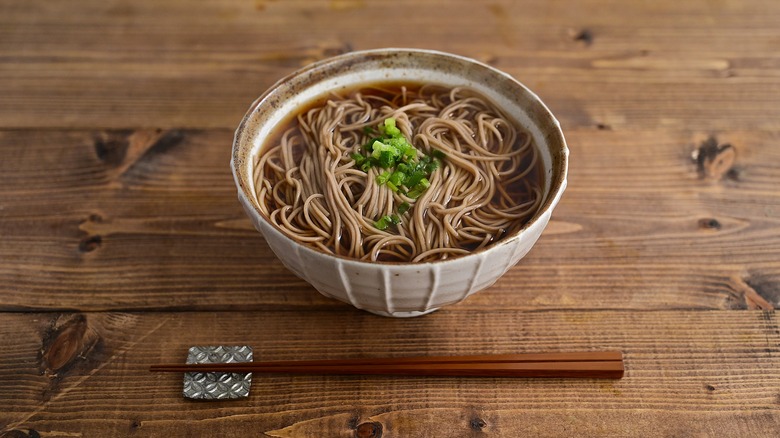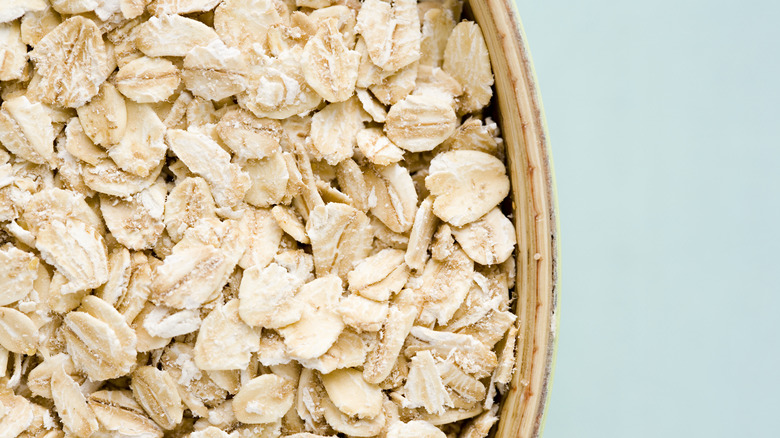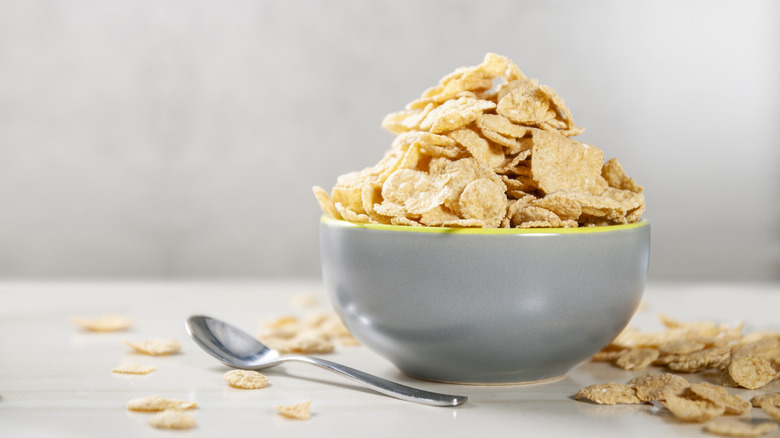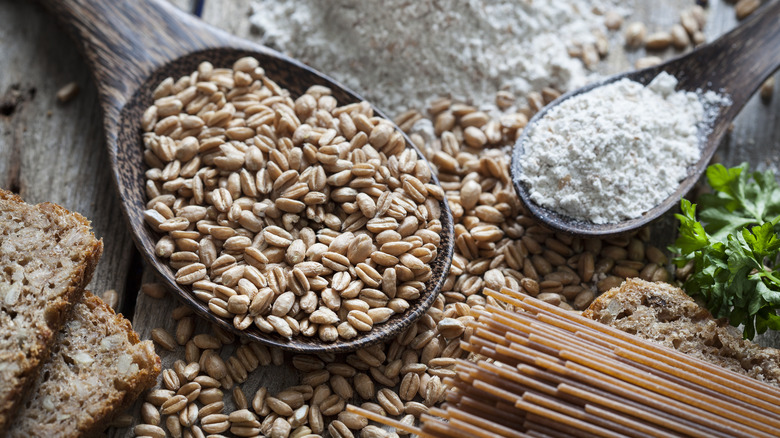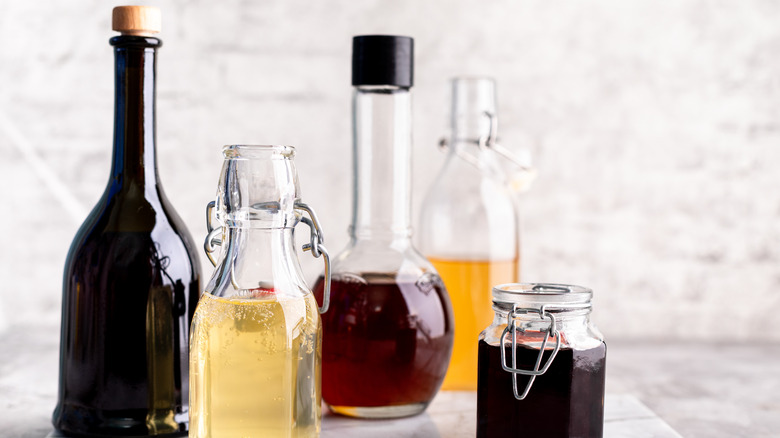14 Foods That You May Think Are Gluten-Free But Aren't
Unless you've been living under a rock, you're well aware of the recent massive surge of interest in gluten and how it affects our diets today. Gluten-free products are popping up on shelves everywhere across the United States in a huge win for those with Celiac disease or other gluten sensitivities. While raising awareness for the general public is overall a good thing, it's also causing some confusion among consumers who may misunderstand what exactly gluten is and whether or not it's bad for you. In short, gluten is simply the collective name for a group of proteins most commonly found in wheat, rye, and barley; all ubiquitous ingredients in our food. While consuming gluten can have negative side effects for people with allergies and sensitivities, it's completely harmless — and beneficial — to those without.
Nonetheless, many people choose to live gluten-free whether or not they have ailments that prevent the proper digestion of gluten — a feat far easier today than it was even a decade ago, thanks to the explosion of G.F. (gluten-free) products in the market. Some gluten-containing products are easily spotted. It can be assumed that items like bread, pasta, pizza, and baked goods contain gluten unless otherwise noted. However, there are a number of foods that appear to be G.F. but are actually sneaky sources of gluten. Here are some to have on your radar if you're following a gluten-free diet.
Soy sauce
While soy on its own is gluten-free, it might surprise you to learn that wheat is one of the main ingredients in everybody's favorite Chinese food accompaniment, soy sauce. Soy sauce is traditionally made by allowing gluten-free soybeans to soak in water before mixing them with roasted and crushed wheat, then combining the mixture with a culturing mold for a few days' fermentation. Because wheat is integral to the recipe, it's essentially impossible to find traditional soy sauce of a gluten-free variety.
Luckily, there are a couple of easy-to-find substitutes for the salty, pungent sauce. Umami-rich tamari is a Japanese soy sauce made with soybeans, but not wheat. It's less salty and a bit smoother than the usual Chinese soy sauce but makes an excellent dupe for those following a G.F. lifestyle. Its lower sodium content is a boon to anyone watching their sodium intake, as well. Avoiding both gluten and soy? Coconut aminos are a fermented soy sauce substitute made from the nectar of the flowers of coconut palm trees. Coconut aminos are gluten and soy-free and carry a similar taste to soy sauce, though aminos fall on the sweeter side. Both tamari and coconut aminos make excellent soy sauce substitutes for anyone who wants to stay gluten-free.
Pre-packaged meats
When it comes to gluten-free foods, meats are typically thought of as a safe bet. When one buys a whole chicken, ground pork or beef, lamb chops, and similar meats at the grocery store, the meat itself is typically the only ingredient listed. While raw, unseasoned, and unprocessed meats are usually completely safe for those with gluten intolerance, pre-packaged meats are a different story. Many processed and pre-packaged meats, like hot dogs, sausages, cured meats, and even deli meats, are not gluten-free. Whether it's due to ingredients like soy sauce in marinades, wheat as a binding agent, or elements like starch or dextrin used in dry seasoning mixes, it's important to read labels carefully when purchasing pre-packaged meats as a G.F. eater.
The safest way to go about buying pre-packaged meats on a gluten-free diet is to seek out products specifically labeled "gluten-free" — even if no allergens are listed in the ingredients, cross-contamination is possible; and in fact, some meat companies buy ingredients from outside vendors which may or may not contain gluten. Better yet, if possible, purchase raw meat and make your own sausages, marinated chicken, or whatever you desire using seasonings, dressings, and marinades made at home to prevent contamination.
Couscous
Wheat is one of the primary sources of gluten in foods today. Although wheat is a part of the grain family, there are a surprising number of grains that don't contain gluten — grains like rice (in its natural form), flax, millet, quinoa, and many others make for nutritious, satiating, and gluten-free bases, side dishes, and main courses. That said, it's important for those following a G.F. diet to know which grains contain gluten and which are acceptable, and it can get tricky with so many different grains to choose from. One common misconception is that couscous is a gluten-free grain when in fact, couscous is neither gluten-free nor a grain at all. Believe it or not, it's actually a type of pasta, though it's rarely eaten the same way as more traditional kinds of pasta like fettuccini, rigatoni, or linguini.
Couscous is made from dry semolina flour (ground durum wheat) mixed with water, forming a dough that is then rolled into teeny-tiny pieces so small they resemble grains. It's the durum wheat semolina flour that disqualifies couscous from the gluten-free category here. If couscous is your jam but you're switching to a G.F. diet, don't fret — there are many gluten-free grains and substitutes that can likely satisfy your craving. Quinoa is similar in its light, fluffy texture, and nutty flavor, and it's packed with protein to boot.
Ice cream
No one is going to tell you ice cream is healthy for you (everything in moderation!), but given that most ice cream is made from heavy cream and sugar, it's safe to assume it's gluten-free, right? Think again — some ice cream isn't gluten-free. There are a couple of ways for gluten to worm its way into the frozen sugar-and-cream concoction we all know and love. Firstly, many ice cream flavors contain mix-ins that contain gluten; so while the base ice cream itself may be safe, the add-ins may include items with wheat or starch. Think cookie dough ice cream — vanilla ice cream on its own may be perfectly fine for those with gluten intolerance, but cookie dough is likely made with wheat-containing flour.
Alternatively, an ice cream flavor you might think is fine because it doesn't have add-ins, like plain vanilla, chocolate, or butterscotch, might contain traces of starches or flavorings that contain gluten — or could be processed on equipment that's exposed to gluten cross-contamination. This isn't to say that all ice cream contains gluten. There are plenty of delicious flavors that are certified gluten-free, including many of our lord and savior Ben & Jerry's creations. Just be sure to double-check ingredients and look for a G.F. label wherever possible.
Licorice
Licorice is one of the world's more controversial candies. You won't find many people in the middle camp when it comes to licorice; typically, people either love it or loathe its herbaceous properties. The sweet-and-bitter, gummy-like string candy comes in red and black forms, with the red variety typically bringing a cherry or strawberry flavor and the black type containing deeper notes of black cherry, tobacco, and the like.
Licorice might not be something that strikes one as an obvious gluten source, being derived from raw licorice root. However, licorice candy is most often made with wheat flour, making it a no-no for those with gluten intolerance or allergy problems. Luckily, if you're a fan of this aromatic candy, there are a number of brands that make gluten-free licorice today. Some are processed with rice flour rather than wheat flour — rice flour's chewy, stretchy consistency lends itself well to the creation of licorice candy. If you're feeling ambitious, you can also make licorice candy right at home to eliminate all risk of coming into contact with gluten.
Whiskey
Liquids can be one of the trickiest parts of eating gluten-free. Items like soup, smoothies, broths, and alcohol may seem like a safe bet, but some of these things actually do contain starches, flours, or seasoning mixes that render them unsafe for G.F. eaters — at least, in trace amounts. Beyond Celiac asserts that most liquor, regardless of its source, is gluten-free due to the distillation process, in which proteins such as gluten are completely removed. Whiskey is usually distilled from rye, wheat, or barley; all gluten-containing grains that contribute to its overall flavor. Given this fact, it sounds like whiskey would be automatically off-limits for those with gluten or wheat allergies, but if gluten is eliminated during the distillation process, what's to worry about?
Turns out, the FDA's regulations on gluten-free labeling are not absolute. Food and beverages can be designated gluten-free as long as they contain less than 20 parts per million of gluten. This is, of course, a super negligible amount, and distilled liquors like whiskey can likely be tolerated by people whose gluten intolerances are mild or those who choose to live a G.F. lifestyle despite not having any issues with the protein. However, for people with Celiac disease or more severe allergies, even these trace amounts of gluten found in whiskey can trigger an autoimmune response. If you're looking for a true gluten-free whiskey, look for whiskey made with sorghum or a similar gluten-free grain instead.
Bouillon
Bouillon cubes or powder are game-changers when it comes to creating a great flavor quickly. Although it was originally designed to make a quick stock or broth, bouillon can be used for everything from creating stock to seasoning meats to adding flavor to sauces and marinades. Bouillon is made from dehydrated stock (which could be beef, chicken, veggie, or even pork or turkey) along with herbs or vegetables, salt, and fat. Seems innocent enough, right? Not so fast — if you're following a strict G.F. diet, there are quite a few ingredients to look out for when purchasing bouillon.
Wheat is the most common red-flag ingredient when it comes to gluten in bouillon. Especially ubiquitous in bouillon cubes, where it helps the cubes maintain their structure, wheat is a very common ingredient in these handy-dandy little seasoning bombs. You should also keep an eye out for yeast extract — it doesn't always contain gluten but may incorporate gluten from barley. Lastly, "natural flavors" are always a caveat. Unless a specific gluten-free grain source is listed on the nutritional label, natural flavors may be derived from barley. Anyone with strict instructions to avoid gluten should steer clear of bouillon cubes or powder with any of these ingredients listed on the label.
Miso
Nothing says umami like miso. Miso has found its way into American kitchens largely due to the popularity of miso paste and miso soup, both of which carry complex and umami-rich salty, sweet, and funky flavors. Miso soup in particular has become a popular comfort food. It's plant-based and bursting with flavor, making it a great option for herbivores and carnivores alike come flu and head cold season. Miso soup's base comes from flavorful soybeans, which are gluten-free, but also grains, meaning many miso paste and soup brands are off-limits to G.F. eaters.
If you're able to find gluten-free miso paste, it's pretty easy to make a simple miso soup recipe at home to eliminate potential gluten sources. Besides G.F. miso paste, you'll want to seek out vegetable stock and whatever other ingredients you like in your miso soup. Common additions include tofu (usually safe for gluten-free folks), mushrooms, ginger, scallions, and soy sauce (in this case, since traditional soy sauce contains gluten, use tamari or coconut aminos). If dining out while avoiding gluten, be sure to ask whether the miso soup is gluten-free before ordering.
Ezekiel bread
Until recently, most people following a gluten-free diet had to avoid bread altogether. Thanks to increased awareness of gluten intolerance and allergies, there are a number of incredible gluten-free breads on the market today, the best of which are indistinguishable from good old whole-grain bread. In fact, the entire bread market has undergone something of a revolution of late, and one of the most popular "superfood"-branded breads to emerge is Ezekiel bread. Ezekiel bread is made from sprouted grains and legumes, which allegedly leads to the creation of flour much richer in proteins and vitamins than your everyday whole wheat or white bread.
Ezekiel bread is packed with nutrients, no doubt. It's low in carbs but high in fiber and protein; but alas, being made with wheat, it is not gluten-free, although it may be lower in gluten than traditional bread. If you're looking to reduce (but not entirely eliminate) gluten from your diet, Ezekiel bread is a delicious and nutritious choice that may serve as a fix for your bread craving without packing too much of a glutinous punch.
Soba noodles
Buckwheat seems to be one of the hottest gluten-free flours on the block. Contrary to its name, buckwheat is not a grain at all but rather derived from a flowering plant. It's been used as a wheat substitute in Asian countries for ages, but now that it's more readily available, it's becoming a lot more common in the U.S., as well. "Soba" is actually Japanese for buckwheat, and indeed, one of the most common places to find buckwheat is in soba noodles, often used in hot noodle soups or in chilled noodle salad concoctions.
Although buckwheat itself is gluten-free, soba noodles rarely are. The thick noodles are typically processed using buckwheat and additional refined wheat flour for shape and structure, so they're not generally safe for anyone on a G.F. diet. There are brands that make soba noodles from just buckwheat, which are gluten-free (assuming no additives with gluten are used), but these aren't as easy to find in stores as the buckwheat and refined wheat noodles. Your best bet is to order soba noodles from a gluten-free source online, or if you're feeling ambitious, make them at home.
Oats
Oats are a healthy, versatile, and tasty addition to many diets. They're an excellent source of fiber, vitamins, and minerals, and are often recommended for those looking to reduce their cholesterol and blood sugar levels. Oats can be used in everything from cookies to breakfast bowls, so in addition to being nutritional powerhouses, they're also expert shapeshifters. Officially, they're classified as gluten-free grains, but not all oats are gluten-free. While oats, in and of themselves, do not contain gluten, many packaged brands are unsafe for people with Celiac disease or other conditions that make them highly sensitive to gluten.
As is the case with many sneaky gluten sources, cross-contamination is the villain here. In many instances, oats are grown in fields next to grains that contain gluten, such as wheat or barley. This means that even oats straight from a field may have come into contact with gluten, which is a big no-no for those with heightened sensitivities. While most store-brand oats won't cause any reaction for those with light sensitivities or people following a G.F. diet for reasons aside from allergies and sensitivities, it's best for those with health-threatening conditions to stick to oats carrying a certified gluten-free label.
Corn flakes
Breakfast cereal is a quick and easy meal and a staple for many American households. It's long been known that many breakfast cereals are loaded with sugar and artificial flavors, but certain types of cereal have gained a reputation as healthier choices. The accidental invention of Kellogg's cornflakes presents an excellent example. Originally developed and marketed by Dr. John Harvey Kellogg in the late 19th century as a health food, Kellogg's cornflakes consisted of just flour, cornmeal, and oats; but cornflakes nowadays are often loaded with sugar and preservatives.
Corn on its own is, in fact, a gluten-free grain; but today, it's difficult to find cornflakes that don't contain malt flavoring at the store. Unfortunately for the G.F. community, malt flavoring contains gluten in the form of barley, so if you're following the lifestyle, most brands of cornflakes (including the infamous Kellogg's) are a no-go. Consider using certified gluten-free granola or oats with honey or comparable gluten-free cereals as an alternative.
Spelt
If you're exploring or have already subscribed to a gluten-free diet, it's helpful to know about different flours. Most of us think of traditional all-purpose flour when the word comes to mind, but today, there are many gluten-free flour available that can easily be swapped into baking recipes, used as thickeners, and more. Unfortunately, spelt is not one of them. Spelt is an ancient grain closely related to wheat and barley. It has a red hue, a sweet and nutty taste, and is absolutely loaded with fiber, manganese, calcium, and other vitamins and minerals; but because it's in the same family as wheat and barley, spelt and spelt flour are not gluten-free.
Luckily, there are plenty of other types of gluten-free flour on the market today, and let's be honest, whose go-to flour is spelt anyway? Arrowroot and tapioca powder make fantastic thickeners, cassava flour is great for pasta dough (and is great for gut health), and coconut flour's sweet taste makes it a fine G.F. substitute for baked goods. If you're only restricting gluten in your diet, spelt may not do much damage — studies show it's easier to digest than wheat flour, which should be sufficient for those restricting gluten for IBS and similar reasons.
Undistilled vinegars
Commonly used to give sauces, dressings, and marinades a bit of brine and tang, many vinegars are completely safe for gluten-free dieters. Similar to alcohol, it's safe to assume that balsamic, rice wine, apple cider, and other vinegars that have undergone a distillation process are free from gluten and fair game, even for those with gluten sensitivities or allergies... but keep an eye out when it comes to un-distilled vinegar.
It's a sneaky one because vinegar seems like such an unlikely source for gluten, but if you're living gluten-free, you certainly don't need to eliminate vinegar from your diet entirely — just stick with distilled varieties of vinegar. Malt vinegar is the primary culprit here, as malt is made from barley. If you're following a recipe that calls for complex, nutty malt vinegar, but you're avoiding gluten, apple cider vinegar or even plain lemon juice will make a fine substitution in most cases.
